Solar eclipse of September 21, 1903
A total solar eclipse occurred on September 21, 1903. A solar eclipse occurs when the Moon passes between Earth and the Sun, thereby totally or partly obscuring the image of the Sun for a viewer on Earth. A total solar eclipse occurs when the Moon's apparent diameter is larger than the Sun's, blocking all direct sunlight, turning day into darkness. Totality occurs in a narrow path across Earth's surface, with the partial solar eclipse visible over a surrounding region thousands of kilometres wide.
| Solar eclipse of September 21, 1903 | |
|---|---|
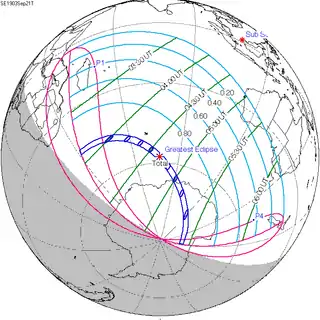 Map | |
| Type of eclipse | |
| Nature | Total |
| Gamma | −0.8967 |
| Magnitude | 1.0316 |
| Maximum eclipse | |
| Duration | 132 sec (2 m 12 s) |
| Coordinates | 58°S 77.2°E |
| Max. width of band | 241 km (150 mi) |
| Times (UTC) | |
| Greatest eclipse | 4:39:52 |
| References | |
| Saros | 123 (47 of 70) |
| Catalog # (SE5000) | 9289 |
Related eclipses
Solar eclipses 1902–1907
This eclipse is a member of a semester series. An eclipse in a semester series of solar eclipses repeats approximately every 177 days and 4 hours (a semester) at alternating nodes of the Moon's orbit.[1]
| Solar eclipse series sets from 1902–1907 | ||||
|---|---|---|---|---|
| Descending node | Ascending node | |||
| 108 | April 8, 1902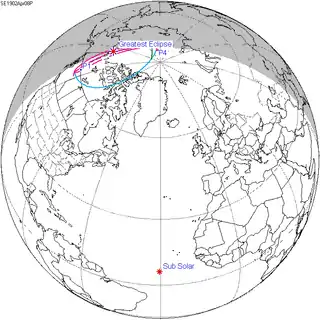 Partial |
113 | October 1, 1902 | |
| 118 | March 29, 1903 Annular |
123 | September 21, 1903 Total | |
| 128 | March 17, 1904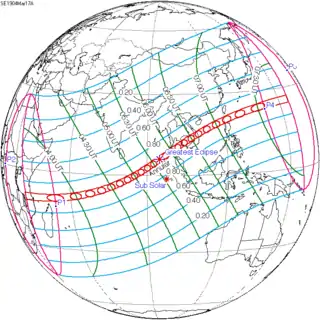 Annular |
133 | September 9, 1904 Total | |
| 138 | March 6, 1905 Annular |
143 | August 30, 1905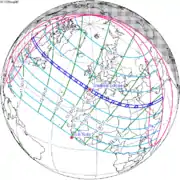 Total | |
| 148 | February 23, 1906 Partial |
153 | August 20, 1906 Partial | |
Inex series
This eclipse is a part of the long period inex cycle, repeating at alternating nodes, every 358 synodic months (≈ 10,571.95 days, or 29 years minus 20 days). Their appearance and longitude are irregular due to a lack of synchronization with the anomalistic month (period of perigee). However, groupings of 3 inex cycles (≈ 87 years minus 2 months) comes close (≈ 1,151.02 anomalistic months), so eclipses are similar in these groupings.
In the 19th century:
- Solar Saros 120: Total Solar Eclipse of 1816 Nov 19
- Solar Saros 121: Hybrid Solar Eclipse of 1845 Oct 30
- Solar Saros 122: Annular Solar Eclipse of 1874 Oct 10
| Inex series members between 1901 and 2100: | ||
|---|---|---|
 September 21, 1903 (Saros 123) |
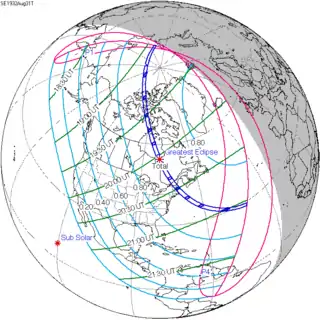 August 31, 1932 (Saros 124) |
 August 11, 1961 (Saros 125) |
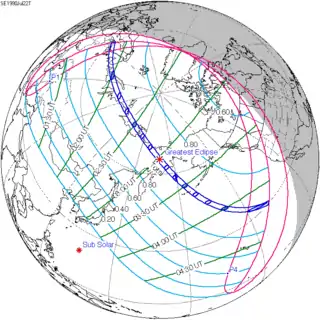 July 22, 1990 (Saros 126) |
 July 2, 2019 (Saros 127) |
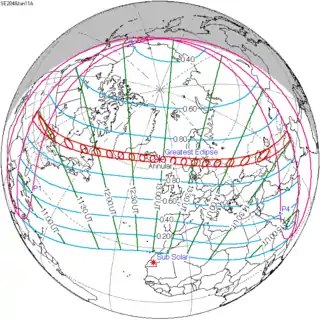 June 11, 2048 (Saros 128) |
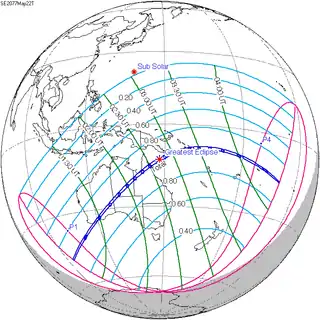 May 22, 2077 (Saros 129) |
||
In the 22nd century:
- Solar Saros 130: Total Solar Eclipse of 2106 May 03
- Solar Saros 131: Annular Solar Eclipse of 2135 Apr 13
- Solar Saros 132: Hybrid Solar Eclipse of 2164 Mar 23
- Solar Saros 133: Total Solar Eclipse of 2193 Mar 03
Tritos series
This eclipse is a part of a tritos cycle, repeating at alternating nodes every 135 synodic months (≈ 3986.63 days, or 11 years minus 1 month). Their appearance and longitude are irregular due to a lack of synchronization with the anomalistic month (period of perigee), but groupings of 3 tritos cycles (≈ 33 years minus 3 months) come close (≈ 434.044 anomalistic months), so eclipses are similar in these groupings.
| Series members between 1901 and 2100 | |||
|---|---|---|---|
 September 21, 1903 (Saros 123) |
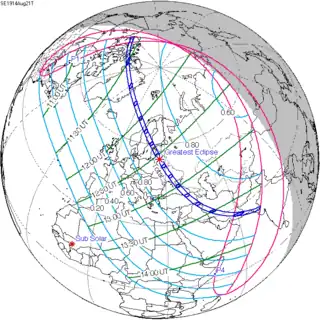 August 21, 1914 (Saros 124) |
 July 20, 1925 (Saros 125) | |
 June 19, 1936 (Saros 126) |
 May 20, 1947 (Saros 127) |
 April 19, 1958 (Saros 128) | |
 March 18, 1969 (Saros 129) |
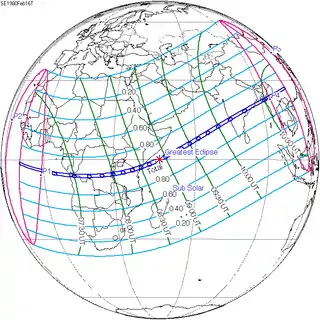 February 16, 1980 (Saros 130) |
 January 15, 1991 (Saros 131) | |
 December 14, 2001 (Saros 132) |
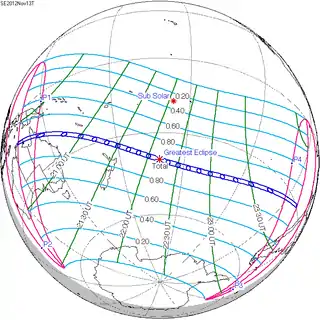 November 13, 2012 (Saros 133) |
 October 14, 2023 (Saros 134) | |
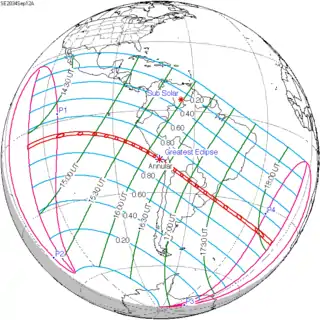 September 12, 2034 (Saros 135) |
 August 12, 2045 (Saros 136) |
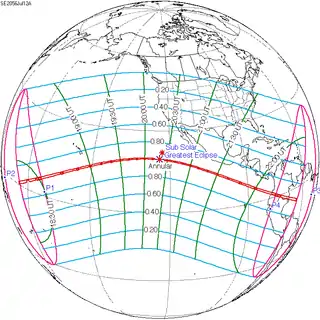 July 12, 2056 (Saros 137) | |
 June 11, 2067 (Saros 138) |
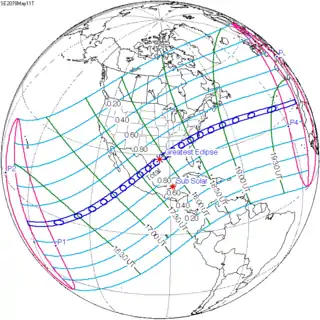 May 11, 2078 (Saros 139) |
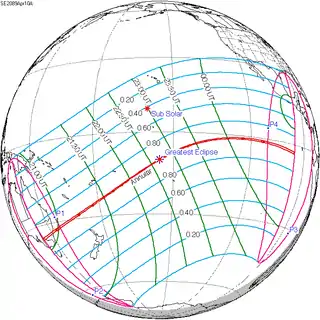 April 10, 2089 (Saros 140) | |
 March 10, 2100 (Saros 141) |
|||
Notes
- van Gent, R.H. "Solar- and Lunar-Eclipse Predictions from Antiquity to the Present". A Catalogue of Eclipse Cycles. Utrecht University. Retrieved 6 October 2018.
References
- Earth visibility chart and eclipse statistics Eclipse Predictions by Fred Espenak, NASA/GSFC
.jpg.webp)

